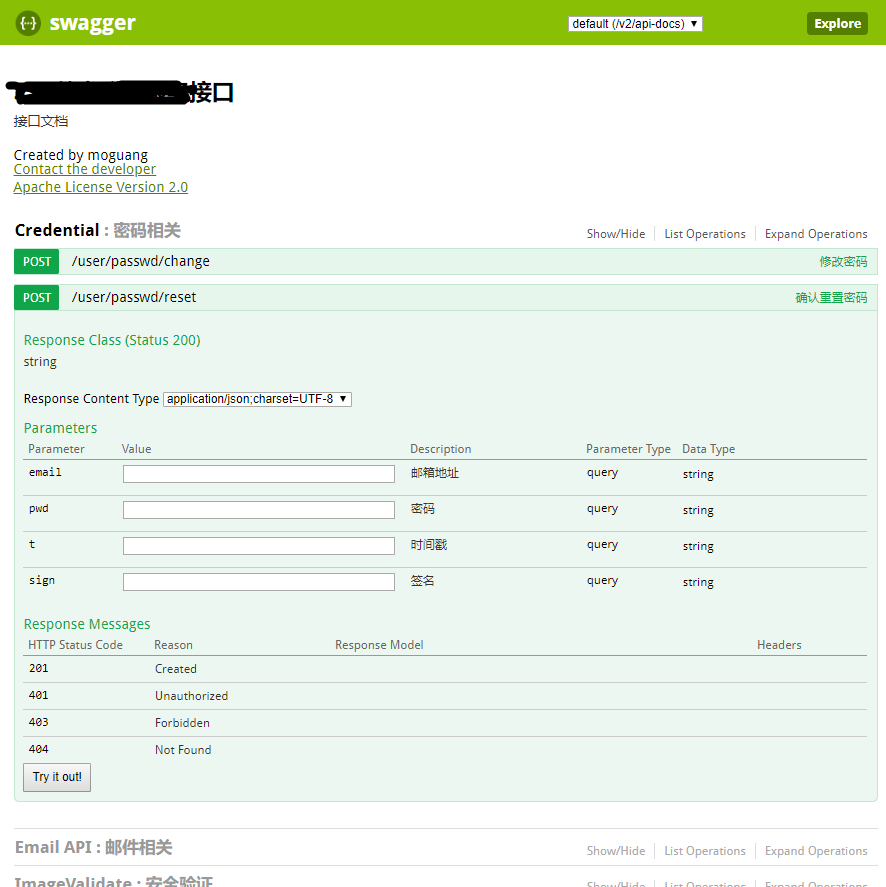1. 关于swagger
我们撰写的接口文档,有面向内部开发者的,也有面向外部的。很多情况下文档和代码是分离的,有好处也有坏处。而当我们写java项目想偷懒,想要自动生成接口文档时,swagger工具是个不错的选择。
在Golang中, godoc时标准化的工具,而java似乎没这么舒服。所以这里借助了swagger第三方工具,swagger是主要用于自动生成restful风格API文档以及方便开发调试的开源组件,可以与springboot友好集成。
2. pom.xml添加依赖
<dependency>
<groupId>io.springfox</groupId>
<artifactId>springfox-swagger2</artifactId>
<version>2.6.1</version>
</dependency>
<dependency>
<groupId>io.springfox</groupId>
<artifactId>springfox-swagger-ui</artifactId>
<version>2.6.1</version>
</dependency>
3. 添加swagger配置
- 新增
SwaggerConfig.java,用于指定基本配置及维护信息:
package com.example.config;
import org.springframework.boot.autoconfigure.condition.ConditionalOnProperty;
import org.springframework.context.annotation.Bean;
import org.springframework.context.annotation.Configuration;
import springfox.documentation.builders.ApiInfoBuilder;
import springfox.documentation.builders.PathSelectors;
import springfox.documentation.builders.RequestHandlerSelectors;
import springfox.documentation.service.ApiInfo;
import springfox.documentation.service.Contact;
import springfox.documentation.spi.DocumentationType;
import springfox.documentation.spring.web.plugins.Docket;
import springfox.documentation.swagger2.annotations.EnableSwagger2;
/**
* @author moguang
* @version 2018/9/20
* @description: SwaggerConfig
*/
@Configuration
@ConditionalOnProperty(prefix = "swagger", value = { "enable" }, havingValue = "true")
@EnableSwagger2
public class SwaggerConfig {
@Bean
public Docket api() {
return new Docket(DocumentationType.SWAGGER_2)
// 指定当前服务的host
.host("example.com:443").forCodeGeneration(true)
// 指定package下生成API文档
.select().apis(RequestHandlerSelectors.basePackage("com.example.controller"))
// 过滤生成链接(any()表示所有url路径)
.paths(PathSelectors.any()).build().apiInfo(apiInfo());
}
// api接口作者相关信息
private ApiInfo apiInfo() {
Contact contact = new Contact("moguang", "", "xxx@qq.com");
ApiInfo apiInfo = new ApiInfoBuilder().license("Apache License Version 2.0").title("Example服务接口")
.description("接口文档").contact(contact).version("1.0").build();
return apiInfo;
}
}
- 新增
WebMvcConfig.java, 用于静态资源路径的注册:
package com.example.config;
import org.springframework.context.annotation.Configuration;
import org.springframework.web.servlet.config.annotation.ResourceHandlerRegistry;
import org.springframework.web.servlet.config.annotation.WebMvcConfigurerAdapter;
import org.springframework.web.servlet.config.annotation.InterceptorRegistry;
@Configuration
public class WebMvcConfig extends WebMvcConfigurerAdapter {
/**
* 配置静态资源路径
*
* @param registry
*/
@Override
public void addResourceHandlers(ResourceHandlerRegistry registry) {
registry.addResourceHandler("/static/**").addResourceLocations("classpath:/static/");
/* swagger-ui */
registry.addResourceHandler("/swagger-ui.html").addResourceLocations("classpath:/META-INF/resources/");
registry.addResourceHandler("/webjars/**").addResourceLocations("classpath:/META-INF/resources/webjars/");
}
}
4. Controller增加swagger注解(示例)
package com.example.controller;
import org.springframework.stereotype.Controller;
import org.springframework.web.bind.annotation.RequestMethod;
import org.springframework.web.bind.annotation.RequestMapping;
import org.springframework.web.bind.annotation.ResponseBody;
import org.springframework.web.bind.annotation.RequestParam;
import io.swagger.annotations.Api;
import io.swagger.annotations.ApiParam;
import io.swagger.annotations.ApiOperation;
@Api(value = "密码相关Controller", description = "密码相关", tags = { "Credential" })
@Controller
public class PasswordController {
@ApiOperation("确认重置密码")
@RequestMapping(value = "/user/passwd/reset", method = RequestMethod.POST, produces = "application/json;charset=UTF-8")
@ResponseBody
public String updatePassword(
@ApiParam("邮箱地址") @RequestParam(name = "email") String email,
@ApiParam("密码") @RequestParam(name = "pwd") String passwd,
@ApiParam("时间戳") @RequestParam(name = "t") String timestamp,
@ApiParam("签名") @RequestParam(name = "sign") String sign) {
// TODO: do something
return "{"code":0}";
}
}
更具体的注解用法可参考其他资料,如:https://www.cnblogs.com/hyl8218/p/8520994.html
5. 运行效果
springboot服务起来后,访问http(s)://yourhost:port/swagger-ui.html可显示如下效果:
6. 生产环境关闭swagger
安全起见,生产环境应当关闭swagger文档。其中一种方法如下:
- SwaggerConfig中增加注解,对配置变量的判断
如上面的SwaggerConfig.java加入的:
@ConditionalOnProperty(prefix = "swagger", value = { "enable" }, havingValue = "true")
- 在application.properties或application-${profile}.properties (或yml文件)增加如下变量:
swagger.enable=false # 关闭
# swagger.enable=true # 开启
关闭后swagger-ui.html仍然可以访问,但此时页面已经没有任何数据。当然,同时把这个url路径直接屏蔽更好。
点击查看更多内容
6人点赞
评论
共同学习,写下你的评论
评论加载中...
作者其他优质文章
正在加载中
感谢您的支持,我会继续努力的~
扫码打赏,你说多少就多少
赞赏金额会直接到老师账户
支付方式
打开微信扫一扫,即可进行扫码打赏哦





